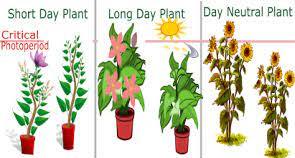PHOTOPERIODISM & VERNALIZATION
Photoperiodism and vernalization both are physiological process in plants which influence the flowering. These are mediated through plant hormones too.
Photoperiodism
The term “Photoperiodism” was firstly used by Garner and Allard in 1920. It is the physiological reaction or developmental responses of plants to the relative length of day and night time (photoperiod). The most important response of photoperiodism in plants is the induction of flowering.
Photoperiodism includes physiological changes throughout the following developmental stages-
- Seed germination
- Flowering
- Bud dormancy
- Rosette and bolting
- Bulb formation
- Leaf fall in deciduous trees
- Growth
Photoperiodic response is categorized into three types briefly described here.
- Short day plants (long night plants) – Such plants flower on photoperiods shorter than the critical day length. For example, Nictiana tobaccum flowers when the dark period is more than 12-hours whereas, critical day length is less than 12-hours. It means long and uninterrupted dark period is crucial for flowering. While, interruption of short light period by dark doesn’t affects flowering whereas, the long dark period is interrupted by even a flash of light, inhibits flowering. Examples– Rice, Jowar, Green gram, Soyabean, Cotton, Marijuana etc.
- Long day plants- Such plants flower when the photoperiod length is greater than the critical day length or flowering is induced by exposure of long days. They require short dark period hence also called short night plants. These plants typically flower during late spring or early summer as days are getting longer. In the northern hemisphere, the longest day of the year (summer solstice) is on or about 21 June.
Examples– Oat, carnation, pea, barley, wheat, lettuce etc.
- Day neutral plants- These plants don’t require any specific photoperiod for flowering, hence also called photo neutral plants or interminate plants. Such plants do not initiate flowering based on photoperiodism instead, they may initiate flowering after attaining a certain developmental stage or age, or in response to alternative environmental stimuli, such as vernalisation.
Examples– cucumbers, roses, tomatoes, and Ruderalis
Vernalization
The exposure of plants/seeds at low temperatures to stimulate flowering or to enhance seed production is called vernalization. It is the induction of plant’s flowering process by exposure to the prolonged cold temperature, or by an artificial equivalent.
- By providing and satisfying the required temperature need of many temperate-zone plants, flowering can be induced to occur earlier than normal or in warm climates lacking the requisite seasonal chilling.
- After vernalization, plants have acquired the ability to flower before they will actually flower.
- The needed cold is often expressed in chill hours (minimum period of cold weather required to blossom). Typical vernalization temperatures are between 1 and 7 degrees Celsius.
- Many perennial plants, like fruit trees pecies, a period of cold is needed first to induce dormancy and then later, after the requisite period of time, re-emerge from that dormancy prior to flowering.
Devernalization is the process of exposing previously vernalized plants/seeds to high temperatures, causing a reversion to the original nonflowering condition. Onion sets that are commercially stored at near freezing temperatures to retard spoilage are thereby automatically vernalized and ready to flower as soon as they are planted.
Frequently Asked Question
What is critical day length?
The length of day or light period in a 24-hour cycle required to induce flowering of long-day plants or to inhibit flowering of short-day plants. When the day length is longer than the critical day length, long-day plants are induced to flower and short-day plants never flower.
What is critical dark period?
The length of night or dark period in a 24-hour cycle required to inhibit flowering of long-day plants or to induce flowering of short-day plants. When the length of night is longer than the critical dark period, short-day plants are induced to flower and long-day plants never flower.
What is Phototropism?
It is response of plants to light direction.
What is Photosensitive?
These are season bound varieties depends on quantity of light received.
Very relatable, if a touch appeasing. Explain?